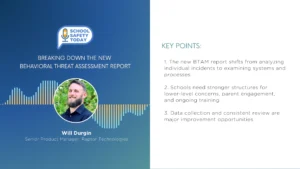What Does it Mean to Have ‘Trauma-Informed’ and ‘Age-Appropriate’ Safety Drills?
In school security news, governors in New Jersey, Texas, and Washington state recently signed legislation with specific active shooter drill parameters. “These states have taken a stance on what they believe should and should not be included in active shooter drills in schools,” said Adam Coughran.
“While the language is a bit different, all these states have taken the stance that drills as it relates to violence and active shooters have to be age-appropriate and trauma-informed,” explained Coughran. According to the Kent Reporter, “over 95% of schools in the United States practice some form of an active shooter drill.”
What does it mean to be ‘trauma-informed’?
Trauma-informed is a common phrase for physical, emotional, and health care. The term is often ‘trauma-informed care.’ Distilling the University of Buffalo’s definition of trauma-informed means “that an individual is more likely than not to have a history of trauma” and “recognizes the presence of trauma symptoms and acknowledges the role trauma may play in an individual’s life- including service staff.”
Currently, active shooter drills can induce trauma. There are reports of students having stress after the training. Coughran points out that sometimes drills “replicate or mimic a real-life situation.” Additionally, the length of time has been poorly communicated to students and staff, resulting in “prolonged drills lasting 15 minutes, 30 minutes, or an hour,” said Coughran.
Drills need to be approached more like a tornado, hurricane, and fire drills in schools. Students and staff need to be aware of the drill’s context, timing and expected length. “Natural disaster-type [drills] things, we don’t take the same stance” as active shooter drills, explains Coughran. After natural disaster prevention drills, there have been minimal reports of trauma induced by the drill.
What does it mean to be “age-appropriate”?
Communicating the drill to first graders versus high schoolers looks completely different. First graders are going to need unique language and visuals. “You can’t have a cartoon story… and expect a high school junior to take that seriously,” explains Coughran, “In the same token, you can’t have a more critical conversation (that you would have with a high schooler) with a first grader.”
It’s best to engage with the school psychologist or social worker to understand students’ needs. Ask questions like: what are they used to seeing? How are they used to learning? What is that audience going to understand? Another resource is the National Association of School Resource Officers.
Trauma-informed and age-appropriate requirements are necessary and good practices for schools nationwide. Coughran knows firsthand that “trauma-informed and age-appropriate are for all of our stakeholders,” from students and staff to parents.








